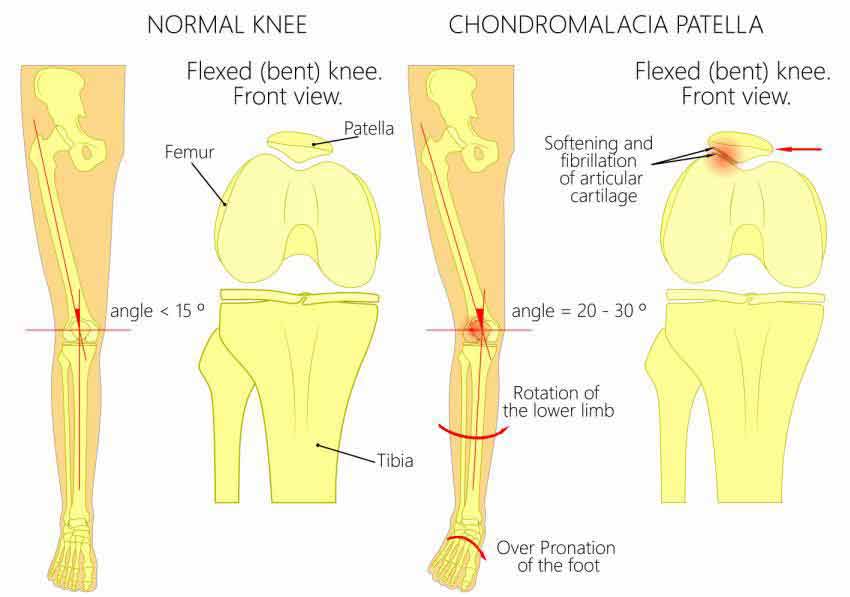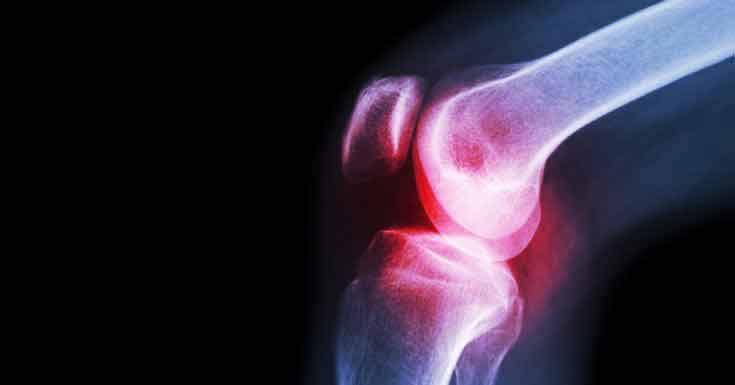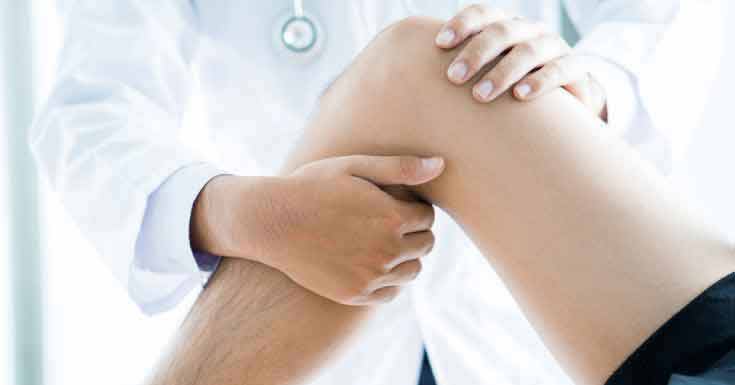Runner’s Knee: Causes, Symptoms, Treatment

Are you a runner and when you run do you experience pain in your knee? If you answered yes then you are part of the increasing number of runners who develop an injury connected to running every other year. Do you live a sedentary type of lifestyle and still feel pain inside your knees? Well, you are also predisposed to chondromalacia patellae otherwise known as runner’s knee.
Sometimes when you stand up from a prolonged seating position where you had your knees slightly bent, or you get up from your desk at work, you feel this sort of tight feeling in the area around your knees. This is knee pain.
Owing to this disorders name (runner’s knee) there is a misconception that you are predisposed to the condition if you are a runner. This cannot be further from the truth! Why? Because you don’t have to be a runner to suffer from runner’s knee. If you cycle often or even walk a lot, you are already predisposed to the condition.
Even if your work involves you sitting at your desk with your knees bent for prolonged hours, you are predisposed to the disorder.
According to Sports Health, 25% of the general population, continues to suffer from runner’s knee. When it comes to running, it accounts for up to 40% of knee pain complaints.
This article states that chondromalacia (runner’s knee) affects one in four people in the United States. Running is one of the most common causes of chondromalacia but you should know that it’s not the only cause. Any activity that you may be involved in that adds pressure or stress, repeatedly to the joint of your knee can end up causing the condition. This includes cycling, walking, skiing and even soccer.
What is Runner’s Knee?
According to an article by health line, chondromalacia or otherwise known as runner’s knee is a type of condition that occurs when the cartilage just under your kneecap abnormally begins to soften up. This softening comes about due to the degeneration of your cartilage.
Degeneration occurs when your kneecap is wrongly aligned as it’s sliding over your femur. This will then cause you to feel pain in your knee specifically in the front area.
Athletes are more susceptible to the condition, especially the young ones. But the old are not spared either as you can also suffer from it if you are an older adult who has knee arthritis.

What Causes Runner’s Knee?
Sometimes this condition can manifest itself for reasons that are unknown. Though most times the usual culprit is when the kneecap is misaligned causing the cartilage just under it to degenerate, thereby causing your knee to pain.
Wearing worn-out shoes – Another cause is when you wear shoes that are worn-out while you exercise and even when you exercise on surfaces that are uneven.
Overusing your legs – When you’re doing lots of strenuous exercises or when you find yourself repeatedly having to bend your knees, such actions can damage the tissues found inside your kneecap.
A direct Trauma to your Knee – If you fall and let’s say you land on your knees, or you get hit by an object on your knee, you might hurt your knee and develop runner’s knee.
Your bones on your kneecap aren’t lined up (mal-aligned): Sometimes if your kneecap is mal-aligned, it won’t be able to move smoothly which will subsequently cause you pain.
You have thigh muscles that are weak and also unbalanced – When you stretch your joint or even bend it your kneecaps are kept in place by some muscles that are found on the front part of your thigh. If these muscles are weak, then you might get the disorder.
Exercising the wrong way: For example, if you exercise with shoes that are already worn-out. Also, if you start doing vigorous exercises quickly without building up by starting with less vigorous exercise, you may well be on your way to getting runner’s knee.
Flat foot: If you have flat feet, this means that the distribution of forces through your knee is changed. This, in turn, makes your cartilage susceptible to being damaged.
How can you Diagnose Runner’s Knee?
Diagnosing the condition is easy. The first thing your doctor will do is to get a history from you. The doctor will need to know how your pain feels like, when and how it started, the kind of movements you make that make the pain worse, and also whether you had in the past injured your knee.
Then the next thing he will do is to conduct a few thorough physical examinations that include, X-rays, CT scans, and even blood tests.

Grading Runner’s Knee
The grades range from 1-4. Grade 1 being the one that has the least severity and grade 4 the most severe.
- Grade 1 – This one shows the knee area cartilage softening.
- Grade 2 – This grade also shows cartilage softening but with additional surface characteristics that are not the usual. This is usually the initialization of erosion of your tissue.
- Grade 3 – This grade indicates the tissue that is actively deteriorating as the cartilage also thins down.
- Grade 4 – Being the most severe, this grade shows a big portion of your cartilage that has deteriorated, including exposure of your bone. When your bone is exposed, this means that the bones in your knee will more than likely rub together.
What are the Symptoms?
- You feel pain on the front of your knee on the inner side. This pain is usually a dull type of pain but it’s heightened by activities like when you are getting down a fleet of stairs, or when you’re running, or even when you’re jumping.
- You could also experience tightness in your knee. This happens especially if your knee swells.
- Moving your knee joint past a certain angle becomes hard. You may experience this when you do any activity that requires you to keep bending your knee in a repeated motion, like walking down a fleet of stairs.
- Your knee may swell up and become red.
- You find it hard to do simple activities like walking, running or even just squatting. This is especially when you are on terrain that’s uneven.
- Your knees may feel weak and may produce a clicking noise when you make any move.
- You get pain in your knees after you have been resting seated for a long time.
How it’s treated?
Most doctors will opt to try treating your condition using treatments that don’t require surgery first, according to Hard Health Online. Your treatment will be tailored to what exactly is causing the disorder.
Using ice on the knee area: You can try and apply some ice and compress the area. This will reduce the swelling and it will help you to recover speedily. It’s advisable that you use ice on your knee area before you begin your activity and also after.
Using Physical Therapy: Look for a licensed physical therapist that will help you in strengthening and balancing your muscles. This will go a long way in the treatment of the disorder.

Engage in Specific exercises: There are some specific exercises that you can do that will help restore the strength of your knees and also motion.
Elevating your knee: To prevent any further swelling to your knee, you should always place a pillow under it when you are sitting.
Using brace straps: In an effort to relieve pressure on your joint, you can use a bracing strap under your kneecap. The brace strap will provide you with support and relief from pain.
Resorting to Surgery: In most cases, surgery is not necessary, but if all fails and you are still experiencing pain, then you can resort to surgery. First, it’s important that your joint is examined so as to find out whether your knee is misaligned. This is done through a type of surgery called arthroscopic surgery. Here, a camera is inserted into your joint and if there is a misalignment, it may be fixed.
There’s also another surgical option where your kneecap is smoothed out among others. If you are not keen on the above ways of treating the condition, you can resort to natural treatment of the condition.
Who is at the Greatest Risk?
There are specific factors that put you at a risk of getting runner’s knee. Let’s look at some of them.
Age Matters – Young adults are at a risk of developing the condition. Why? Well, if you are a young adult, then you are prone to experience growth spurts which involve the rapid development of your muscles. Your bones to are not left behind. This ultimately lead to your muscles developing some imbalances.
Your Gender – If you are a female, according to Harvard Medical School, you are more prone to get the disorder. This is because as a female the mass of your muscle is less, as compared to your male counterpart. Also, you can easily suffer from the abnormal positioning of your knees which also may include pressure on the sides of your kneecaps, making you more likely to develop runner’s knee
Also, if you suffer from knock knees, or you are a runner who is flat-footed, you are generally predisposed to this condition.
You were born with flat feet – Some people are born with flat feet. This means that your knees will experience more stress as compared to someone who has a higher arch.
Past Injury – If you had an injury to your kneecap in the past, you would be more susceptible to runner’s knee.
High strenuous activity – If you are frequently involved in activities that are strenuous and that exert pressure on the knee joint area, you are more prone to runner’s knee.
You suffer from arthritis – Sometimes runner’s knee can be an arthritis symptom.

How to Prevent it?
If you are an athlete, try and not put unnecessary pressure on your joints. You know how we are always advised to warm up before any exercise? well, this is very important here. It’s advised that you stretch before any physical and engaging activities.
Also, it’s advisable that if you are obese, it’s crucial that you work on reducing your weight. Because your weight may add to the stress in your knees. You need to protect your knees so that they don’t experience stress. I suggest using a knee pad when you can, especially if your work involves kneeling on surfaces that are hard.
You should wear shoes that increase your arch, this way, the pressure will be decreased around your knees. If you have flat feet, orthotics will help your feet
Conclusion
It’s important that you remember that runner’s knee does not only affect runners. Another thing that is important to note is that you don’t have to have an overly active lifestyle to get the disorder. Even if you live a sedentary lifestyle, you can still suffer from it.
Something else, if you haven’t exercised in years, then you are prone to get injured in your legs more often, which may inevitably lead to runner’s knee. I suggest, if you have pain in your knee area, that persists, especially around your joint, then it is best to seek medical help.




Post a Comment